Despite the amount of work that takes place within commercial buildings, they consume the least amount of energy out of all the sectors in the US. Currently consuming roughly 20 percent of energy used in the nation, they are behind residential use (about a quarter of the energy consumed) and far behind transportation and industrial – approximately 25 and 30 percent respectively. Although they are the most sustainable – a term we’re using loosely – there still is much room for improvement.
A study by the Pike Research Group has indicated that one third of businesses are due for retrofits that can reduce energy consumption from 10 to 50 percent. While adoption of sweeping reforms within companies in terms of sustainability is lower than desired, it’s not for the reason you might expect. Companies are holding back on these changes because the trouble and inconvenience of retrofits could upset the flow of business for both employees and clients, offsetting any gains the reduced energy costs have on their bottom line.
businesses are due for retrofits that can reduce energy consumption from 10 to 50 percent. While adoption of sweeping reforms within companies in terms of sustainability is lower than desired, it’s not for the reason you might expect. Companies are holding back on these changes because the trouble and inconvenience of retrofits could upset the flow of business for both employees and clients, offsetting any gains the reduced energy costs have on their bottom line.
In this article by Chuck Colgan he illustrates how simple (yet important) changes to the infrastructure of a mixed use building can dramatically lower costs, without being overly intrusive. Some highlights include:
-$66,000 savings annually through general equipment upgrades such as energy efficient lighting, and variable fans
-Correcting settings in the building management system that controls the fan override system, and heating and cooling coils can deliver $230,000 savings every year
There’s no question that businesses must look at the bottom line when running their operations. However, using the excuse that sustainability initiatives can get in the way of business is unacceptable if solutions like those outlined above are available and cause little intrusion on the workplace.
